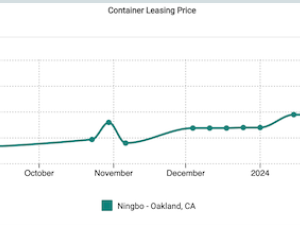Robust Asia imports underscore need to improve freight rates
posted by AJOT | Feb 04 2015 at 01:45 PM | Liner Shipping
Cargo demand for Asian containerized imports has remained strong through the typically slower winter season and heading into the Lunar New Year holidays, according to container line data collected by the Transpacific Stabilization Agreement (TSA).
TSA carriers report consistently full sailings into the Pacific Northwest and via all-water Panama and Suez routes to the U.S. East and Gulf Coasts, as well as 95% utilization or better through California ports hardest hit by congestion. This suggests an overall strong market apart from recent cargo diversion trends, and is consistent with broader indicators of economic growth affecting the Asia-U.S. trade over 2014. In particular, the U.S. Commerce Department’s Bureau of Economic Analysis reports that consumer spending rose 3.5% in 2014 on goods overall, and 6.7% on durable goods; and that retail sales rose 3.2% in 2014 and 4.1% year on year in Q4 alone.
Key containerized import sectors – home furnishings, building and garden supplies, electronics, sporting goods, health and personal care – all reported 4-7% sales gains. The Conference Board’s consumer confidence index is at its highest level since August 2007, fueled in large part by job growth and sharply lower gasoline prices. JOC-PIERS reports 6.1% U.S. containerized import growth in 2014 and forecasts 6.8% growth in 2015; after 2.4% annual GDP growth in 2014, JOC-PIERS forecasts 3.1% growth in 2015.
The current environment has encouraged TSA lines to move ahead with revenue improvement measures which they say will help support continued carrier service investments heading into the pre- and post-Lunar New Year shipping periods, while laying a sustainable pricing foundation for 2015-16 service contracts.
TSA reaffirmed support for a recommended US$600 per 40-foot container (FEU) increase in rates across the board, effective February 9, 2015, and indicated that it will follow with a second $600 per FEU increase on March 9, with an April increase likely to follow, in an amount to be determined and announced later.
Member lines have also recommended upward adjustment of previously announced guideline minimum service contract rates to reflect increases of $300 per FEU for the U.S. East/Gulf Coast minimum, and $200 per FEU for the Chicago CY intermodal minimum. Revised minimum contract rate levels are as follows, with proportionate levels for other equipment sizes:
U.S. West Coast
$2,000 per FEU from North Asia
$2,150 per FEU from Southeast Asia
U.S.East/Gulf Coasts
$3,800 per FEU from North Asia
$3,950 per FEU from Southeast Asia
Inland to Chicago CY
$4,100 from North Asia
$4,250 from Southeast Asia
Intermodal rates to all other inland point CY destinations will be set at a inimum $1,000 per FEU above May 1, 2014 all-in levels. All minimum rates are based on a Q2 2015 bunker charge level, to be published in late February.
Finally, TSA members stressed the need to optimize equipment flow and move cargo efficiently given recent operational challenges, and therefore have committed to avoid exemptions to, or reductions of, special equipment, service and other non-rate items in 2015-16 contracts.
“The transpacific freight market is maturing,” suggested TSA executive administrator Brian Conrad. “We should not continue to measure it against double-digit annual growth seen a decade ago, but rather in the context of a healthy, steadily improving trade.” He added that, similarly, the excess vessel supply reported globally is often overstated in the transpacific because it does not take into account infrastructure and other operational constraints. “The primary imbalance in the transpacific is not so much one of supply versus demand,” Conrad explained, “but rather one of costs versus revenue, that in turn drives service.”
Container lines are forecasting significant increases in shoreside and inland rail, truck and equipment management costs during 2015 and beyond as demand remains strong, as cargo and equipment imbalances widen, and as locomotive, truck and equipment shortages in key locations push up rates. These conditions reflect long-term operational challenges separate from the ongoing labor contract negotiations, and are not expected to be quickly resolved.




